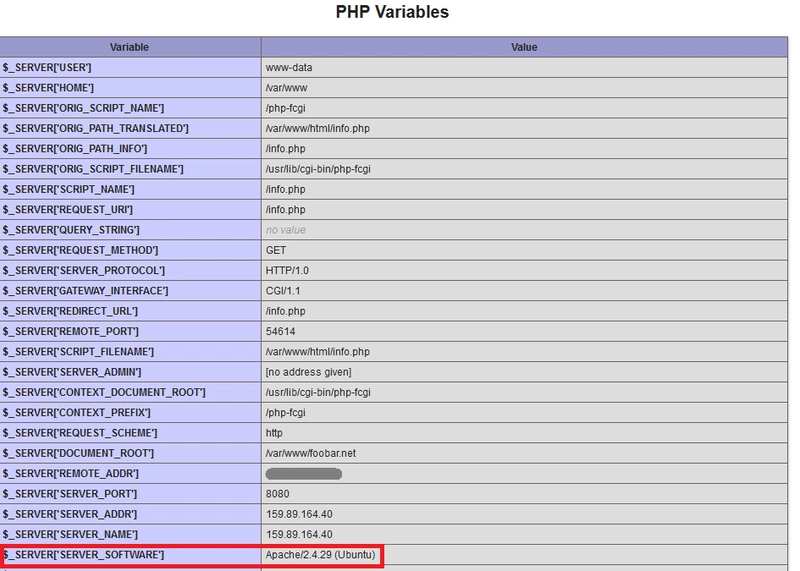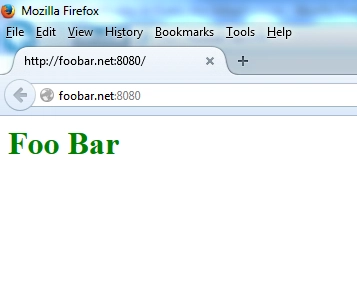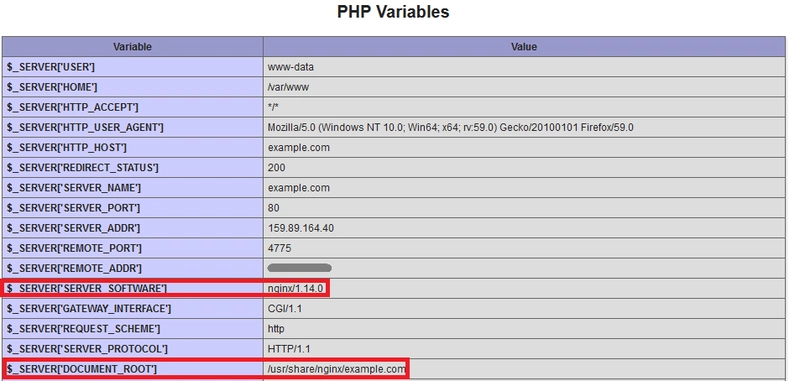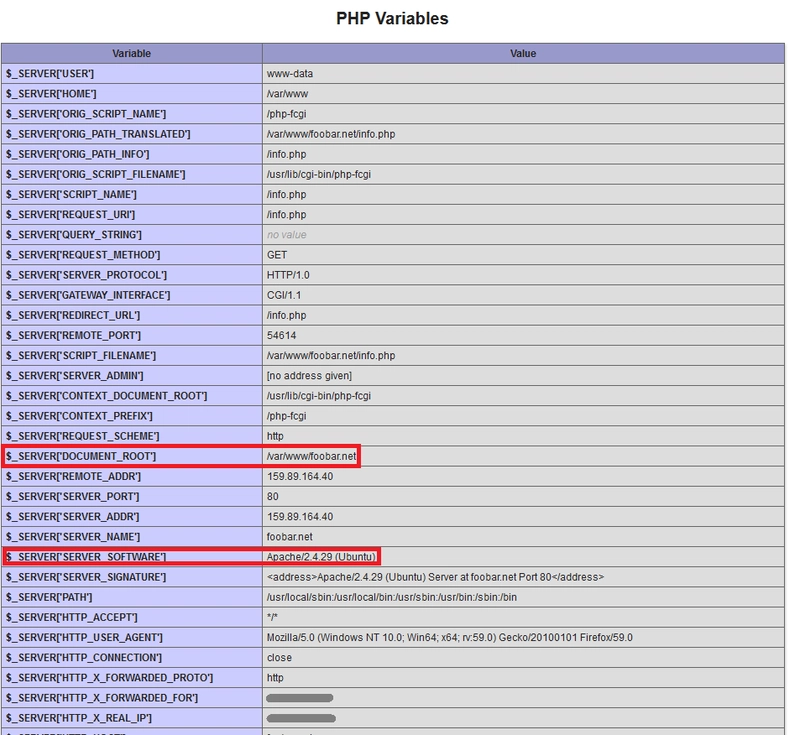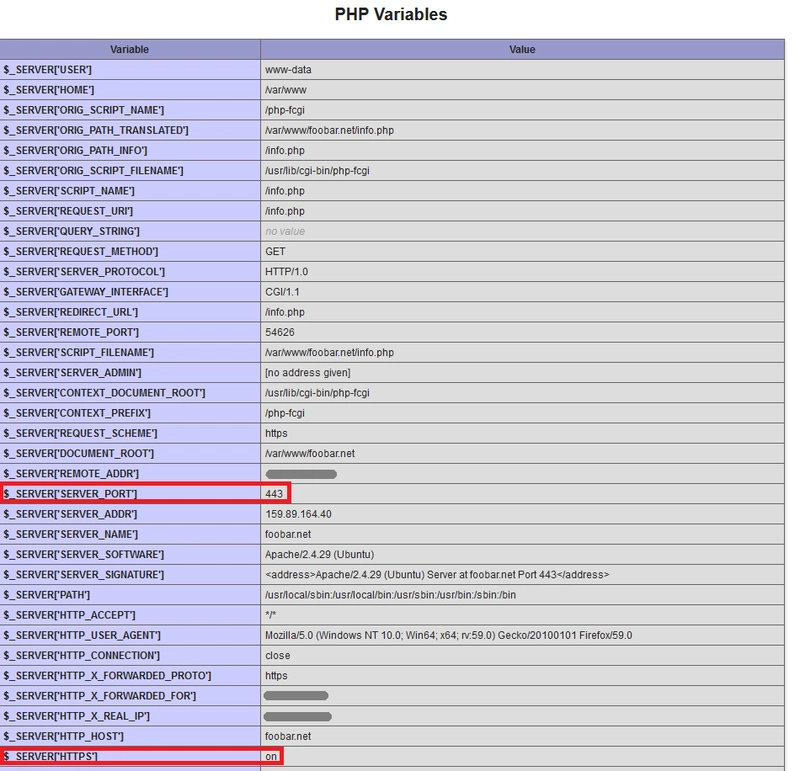如何在一台 Ubuntu 18.04 服务器上将 Nginx 配置为 Web 服务器和 Apache 的反向代理
作者:Jesin A
作者选择电子前沿基金会作为Write for DOnations计划的一部分接受捐赠。
介绍
Apache 和 Nginx 是两个经常与 PHP 配合使用的开源 Web 服务器。当托管多个需求各异的网站时,在同一虚拟机上运行这两个服务器会非常有用。在单个系统上运行两个 Web 服务器的通用解决方案是使用多个 IP 地址或不同的端口号。
可以将同时拥有 IPv4 和 IPv6 地址的服务器配置为使用一种协议为 Apache 网站提供服务,使用另一种协议为 Nginx 网站提供服务,但这目前并不实际,因为 ISP 尚未广泛采用 IPv6。为第二台 Web 服务器设置不同的端口号(例如81或 )8080是另一种解决方案,但使用端口号共享 URL(例如http://example.com:81)并不总是合理或理想的。
在本教程中,您将把 Nginx 配置为 Web 服务器和 Apache 的反向代理 - 所有这些都在一台服务器上进行。
根据 Web 应用程序的不同,可能需要修改代码才能使 Apache 保持反向代理感知,尤其是在配置了 SSL 站点的情况下。为了避免这种情况,您需要安装一个名为 的 Apache 模块,mod_rpaf该模块会重写某些环境变量,使 Apache 看起来好像直接处理来自 Web 客户端的请求。
我们将在一台服务器上托管四个域名。其中两个域名将由 Nginx 提供服务:(example.com默认虚拟主机)和sample.org。其余两个域名(foobar.net和test.io)将由 Apache 提供服务。我们还将配置 Apache 使用 PHP-FPM 来服务 PHP 应用程序,PHP-FPM 的性能优于mod_php。
先决条件
要完成本教程,您需要以下内容:
- 按照 Ubuntu 18.04 的初始服务器设置配置新的 Ubuntu 18.04 服务器,并配备 sudo 非 root 用户和防火墙。
- 配置四个完全限定域名,用于指向您服务器的 IP 地址。请参阅“如何使用 DigitalOcean 设置主机名”中的步骤 3 ,了解如何操作。如果您将域名的 DNS 托管在其他位置,则应在该位置创建相应的 A 记录。
第1步 - 安装Apache和PHP-FPM
让我们从安装 Apache 和 PHP-FPM 开始。
除了 Apache 和 PHP-FPM,我们还将安装 PHP FastCGI Apache 模块,libapache2-mod-fastcgi以支持 FastCGI Web 应用程序。
首先,更新您的软件包列表以确保您拥有最新的软件包。
sudo apt update
接下来,安装 Apache 和 PHP-FPM 包:
sudo apt install apache2 php-fpm
FastCGI Apache 模块在 Ubuntu 的存储库中不可用,因此请从kernel.org下载它并使用dpkg命令安装它。
wget https://mirrors.edge.kernel.org/ubuntu/pool/multiverse/liba/libapache-mod-fastcgi/libapache2-mod-fastcgi_2.4.7~0910052141-1.2_amd64.deb
sudo dpkg -i libapache2-mod-fastcgi_2.4.7~0910052141-1.2_amd64.deb
接下来,让我们将 Apache 的默认配置更改为使用 PHP-FPM。
第2步 - 配置Apache和PHP-FPM
在此步骤中,我们将更改 Apache 的端口号,8080并将其配置为使用该mod_fastcgi模块与 PHP-FPM 一起使用。重命名 Apache 的ports.conf配置文件:
sudo mv /etc/apache2/ports.conf /etc/apache2/ports.conf.default
创建一个新ports.conf文件,并将端口设置为8080:
echo "Listen 8080" | sudo tee /etc/apache2/ports.conf
注意:127.0.0.1:8080配置反向代理时,Web 服务器通常会设置为监听,但这样做会将 PHP 的环境变量SERVER_ADDR的值设置为环回 IP 地址,而不是服务器的公网 IP。我们的目标是设置 Apache,使其网站在其前端看不到反向代理。因此,我们将它配置为监听8080所有 IP 地址。
接下来,我们将为 Apache 创建一个虚拟主机文件。<VirtualHost>此文件中的指令将设置为仅在端口 上为网站提供服务8080。
禁用默认虚拟主机:
sudo a2dissite 000-default
然后创建一个新的虚拟主机文件,使用现有的默认站点:
sudo cp /etc/apache2/sites-available/000-default.conf /etc/apache2/sites-available/001-default.conf
现在打开新的配置文件:
sudo nano /etc/apache2/sites-available/001-default.conf
将监听端口更改为8080:
/etc/apache2/sites-available/000-default.conf
<VirtualHost *:8080>
ServerAdmin webmaster@localhost
DocumentRoot /var/www/html
ErrorLog ${APACHE_LOG_DIR}/error.log
CustomLog ${APACHE_LOG_DIR}/access.log combined
</VirtualHost>
保存文件并激活新的配置文件:
sudo a2ensite 001-default
然后重新加载Apache:
sudo systemctl reload apache2
验证 Apache 现在正在监听8080:
sudo netstat -tlpn
输出应类似于以下示例,并apache2开启监听8080:
OutputActive Internet connections (only servers)
Proto Recv-Q Send-Q Local Address Foreign Address State PID/Program name
tcp 0 0 0.0.0.0:22 0.0.0.0:* LISTEN 1086/sshd
tcp6 0 0 :::8080 :::* LISTEN 4678/apache2
tcp6 0 0 :::22 :::* LISTEN 1086/sshd
一旦您验证 Apache 正在监听正确的端口,您就可以配置对 PHP 和 FastCGI 的支持。
第3步 - 配置Apache以使用mod_fastcgi
Apache 默认使用 PHP 页面提供服务mod_php,但需要额外的配置才能与 PHP-FPM 配合使用。
注意:如果您在现有的带有 mod_php 的 LAMP 安装上尝试本教程,请先使用 禁用它sudo a2dismod php7.2。
我们将添加一个mod_fastcgi依赖于的配置块mod_action。mod_action默认情况下是禁用的,因此我们首先需要启用它:
sudo a2enmod actions
重命名现有的 FastCGI 配置文件:
sudo mv /etc/apache2/mods-enabled/fastcgi.conf /etc/apache2/mods-enabled/fastcgi.conf.default
创建一个新的配置文件:
sudo nano /etc/apache2/mods-enabled/fastcgi.conf
将以下指令添加到文件以将.php文件请求传递到 PHP-FPM UNIX 套接字:
/etc/apache2/mods-enabled/fastcgi.conf
<IfModule mod_fastcgi.c>
AddHandler fastcgi-script .fcgi
FastCgiIpcDir /var/lib/apache2/fastcgi
AddType application/x-httpd-fastphp .php
Action application/x-httpd-fastphp /php-fcgi
Alias /php-fcgi /usr/lib/cgi-bin/php-fcgi
FastCgiExternalServer /usr/lib/cgi-bin/php-fcgi -socket /run/php/php7.2-fpm.sock -pass-header Authorization
<Directory /usr/lib/cgi-bin>
Require all granted
</Directory>
</IfModule>
保存更改并进行配置测试:
sudo apachectl -t
如果显示Syntax OK,则重新加载 Apache :
sudo systemctl reload apache2
如果您看到警告Could not reliably determine the server's fully qualified domain name, using 127.0.1.1. Set the 'ServerName' directive globally to suppress this message.,可以暂时忽略它。我们稍后会配置服务器名称。
现在让我们确保我们可以从 Apache 提供 PHP 服务。
第4步 - 验证PHP功能
phpinfo()让我们通过创建一个文件并从 Web 浏览器访问它来确保 PHP 正常工作。
/var/www/html/info.php创建包含函数调用的文件phpinfo:
echo "<?php phpinfo(); ?>" | sudo tee /var/www/html/info.php
要在浏览器中查看该文件,请转到http://your_server_ip:8080/info.php。这将提供 PHP 正在使用的配置设置列表。您将看到类似如下的输出:
在页面顶部,检查服务器 API是否显示为FPM/FastCGI。在页面向下约三分之二处,“PHP 变量”部分会显示SERVER_SOFTWARE是 Ubuntu 上的 Apache。这确认该服务mod_fastcgi处于活动状态,并且 Apache 正在使用 PHP-FPM 来处理 PHP 文件。
第5步 - 为Apache创建虚拟主机
让我们为域名foobar.net和创建Apache虚拟主机文件test.io。为此,我们首先为两个站点创建文档根目录,并在这些目录中放置一些默认文件,以便我们轻松测试配置。
首先,创建文档根目录:
sudo mkdir -v /var/www/foobar.net /var/www/test.io
然后为每个站点创建一个index文件:
echo "<h1 style='color: green;'>Foo Bar</h1>" | sudo tee /var/www/foobar.net/index.html
echo "<h1 style='color: red;'>Test IO</h1>" | sudo tee /var/www/test.io/index.html
然后为每个站点创建一个phpinfo()文件,以便我们可以测试 PHP 是否配置正确。
echo "<?php phpinfo(); ?>" | sudo tee /var/www/foobar.net/info.php
echo "<?php phpinfo(); ?>" | sudo tee /var/www/test.io/info.php
现在为域创建虚拟主机文件foobar.net:
sudo nano /etc/apache2/sites-available/foobar.net.conf
将以下代码添加到文件来定义主机:
/etc/apache2/sites-available/foobar.net.conf
<VirtualHost *:8080>
ServerName foobar.net
ServerAlias www.foobar.net
DocumentRoot /var/www/foobar.net
<Directory /var/www/foobar.net>
AllowOverride All
</Directory>
</VirtualHost>
该线路AllowOverride All可提供.htaccess支持。
这些只是最基本的指令。有关在 Apache 中设置虚拟主机的完整指南,请参阅如何在 Ubuntu 16.04 上设置 Apache 虚拟主机。
保存并关闭文件。然后为 创建一个类似的配置test.io。首先创建文件:
sudo nano /etc/apache2/sites-available/test.io.conf
然后在文件中添加配置:
/etc/apache2/sites-available/test.io.conf
<VirtualHost *:8080>
ServerName test.io
ServerAlias www.test.io
DocumentRoot /var/www/test.io
<Directory /var/www/test.io>
AllowOverride All
</Directory>
</VirtualHost>
保存文件并退出编辑器。
现在两个 Apache 虚拟主机都已设置完毕,请使用以下a2ensite命令启用站点。这将在目录中创建指向虚拟主机文件的符号链接sites-enabled:
sudo a2ensite foobar.net
sudo a2ensite test.io
再次检查 Apache 是否存在配置错误:
sudo apachectl -t
如果没有错误,您将看到“语法正常” 。如果您发现其他错误,请检查配置并重试。
一旦您的配置没有错误,请重新加载 Apache 以应用更改:
sudo systemctl reload apache2
要确认网站正常运行,请http://foobar.net:8080在http://test.io:8080浏览器中打开并验证每个网站是否显示其index.html文件。
您将看到以下结果:
另外,通过访问每个站点的info.php文件来确保 PHP 正常运行。在浏览器中访问http://foobar.net:8080/info.php和。http://test.io:8080/info.php
您将在每个站点上看到与步骤 4 中相同的 PHP 配置规范列表。
我们现在在 Apache 上托管了两个网站,端口为8080。接下来让我们配置 Nginx。
第6步 - 安装和配置Nginx
在此步骤中,我们将安装 Nginx,并将域example.com和配置sample.org为 Nginx 的虚拟主机。有关在 Nginx 中设置虚拟主机的完整指南,请参阅如何在 Ubuntu 18.04 上设置 Nginx 服务器块(虚拟主机)。
使用包管理器安装 Nginx:
sudo apt install nginx
然后删除默认虚拟主机的符号链接,因为我们不再使用它:
sudo rm /etc/nginx/sites-enabled/default
我们稍后将创建自己的默认站点(example.com)。
现在我们将使用与 Apache 相同的步骤为 Nginx 创建虚拟主机。首先为两个网站创建文档根目录:
sudo mkdir -v /usr/share/nginx/example.com /usr/share/nginx/sample.org
我们将 Nginx 网站保留在 中/usr/share/nginx,这是 Nginx 默认设置的位置。您可以将它们/var/www/html与 Apache 网站放在一起,但这种分离方式可能有助于您将网站与 Nginx 关联起来。
与 Apache 虚拟主机一样,在设置完成后创建index和文件以进行测试:phpinfo()
echo "<h1 style='color: green;'>Example.com</h1>" | sudo tee /usr/share/nginx/example.com/index.html
echo "<h1 style='color: red;'>Sample.org</h1>" | sudo tee /usr/share/nginx/sample.org/index.html
echo "<?php phpinfo(); ?>" | sudo tee /usr/share/nginx/example.com/info.php
echo "<?php phpinfo(); ?>" | sudo tee /usr/share/nginx/sample.org/info.php
现在为域创建一个虚拟主机文件example.com:
sudo nano /etc/nginx/sites-available/example.com
Nginx 调用server {. . .}配置文件服务器块的区域。为主虚拟主机创建一个服务器块。example.com该default_server配置指令使其成为默认虚拟主机,用于处理与任何其他虚拟主机都不匹配的 HTTP 请求。
/etc/nginx/sites-available/example.com
server {
listen 80 default_server;
root /usr/share/nginx/example.com;
index index.php index.html index.htm;
server_name example.com www.example.com;
location / {
try_files $uri $uri/ /index.php;
}
location ~ \.php$ {
fastcgi_pass unix:/run/php/php7.2-fpm.sock;
include snippets/fastcgi-php.conf;
}
}
保存并关闭文件。现在为Nginx的第二个域名创建一个虚拟主机文件sample.org:
sudo nano etc/nginx/sites-available/sample.org
将以下内容添加到文件:
/etc/nginx/sites-available/sample.org
server {
root /usr/share/nginx/sample.org;
index index.php index.html index.htm;
server_name sample.org www.sample.org;
location / {
try_files $uri $uri/ /index.php;
}
location ~ \.php$ {
fastcgi_pass unix:/run/php/php7.2-fpm.sock;
include snippets/fastcgi-php.conf;
}
}
保存并关闭文件。
然后通过创建指向目录的符号链接来启用两个站点sites-enabled:
sudo ln -s /etc/nginx/sites-available/example.com /etc/nginx/sites-enabled/example.com
sudo ln -s /etc/nginx/sites-available/sample.org /etc/nginx/sites-enabled/sample.org
然后测试 Nginx 配置以确保没有配置问题:
sudo nginx -t
如果没有错误,则重新加载 Nginx:
sudo systemctl reload nginx
现在通过访问http://example.com/info.php和http://sample.org/info.php在Web浏览器中访问phpinfo()Nginx虚拟主机的文件。再次查看PHP变量部分。
["SERVER_SOFTWARE"]应该显示为nginx,表明这些文件由 Nginx 直接提供服务。["DOCUMENT_ROOT"]应该指向您在此步骤中为每个 Nginx 站点创建的目录。
至此,我们已经安装了 Nginx 并创建了两个虚拟主机。接下来,我们将配置 Nginx 来代理托管在 Apache 上的域名的请求。
第7步 - 为Apache的虚拟主机配置Nginx
让我们在指令中创建一个额外的 Nginx 虚拟主机,其中包含多个域名server_name。对这些域名的请求将被代理到 Apache。
创建一个新的 Nginx 虚拟主机文件以将请求转发到 Apache:
sudo nano /etc/nginx/sites-available/apache
添加以下代码块,指定两个 Apache 虚拟主机域的名称,并将其请求代理到 Apache。请记住在 中使用公网 IP 地址proxy_pass:
/etc/nginx/sites-available/apache
server {
listen 80;
server_name foobar.net www.foobar.net test.io www.test.io;
location / {
proxy_pass http://your_server_ip:8080;
proxy_set_header Host $host;
proxy_set_header X-Real-IP $remote_addr;
proxy_set_header X-Forwarded-For $proxy_add_x_forwarded_for;
proxy_set_header X-Forwarded-Proto $scheme;
}
}
保存文件并通过创建符号链接启用这个新的虚拟主机:
sudo ln -s /etc/nginx/sites-available/apache /etc/nginx/sites-enabled/apache
测试配置以确保没有错误:
sudo nginx -t
如果没有错误,请重新加载Nginx:
sudo systemctl reload nginx
http://foobar.net/info.php打开浏览器并访问浏览器中的URL 。向下滚动到PHP变量部分并检查显示的值。
变量SERVER_SOFTWARE和DOCUMENT_ROOT确认此请求已由 Apache 处理。变量HTTP_X_REAL_IP和HTTP_X_FORWARDED_FOR由 Nginx 添加,应该显示用于访问 URL 的计算机的公网 IP 地址。
我们已经成功设置了 Nginx,将特定域名的请求代理到 Apache。接下来,让我们配置 Apache,设置REMOTE_ADDR变量,就像它直接处理这些请求一样。
第8步 - 安装和配置mod_rpaf
在此步骤中,您将安装一个名为 的 Apache 模块,mod\_rpaf该模块会根据反向代理提供的值重写REMOTE_ADDR、HTTPS和HTTP_PORT的值。如果没有此模块,某些 PHP 应用程序将需要更改代码才能在代理后无缝运行。此模块位于 Ubuntu 的存储库中,libapache2-mod-rpaf但已过时,并且不支持某些配置指令。因此,我们将从源代码安装它。
安装构建模块所需的软件包:
sudo apt install unzip build-essential apache2-dev
从 GitHub 下载最新的稳定版本:
wget https://github.com/gnif/mod_rpaf/archive/stable.zip
解压下载的文件:
unzip stable.zip
切换到包含以下文件的新目录:
cd mod_rpaf-stable
编译并安装模块:
make
sudo make install
接下来,在mods-available目录中创建一个将加载rpaf模块的文件:
sudo nano /etc/apache2/mods-available/rpaf.load
将以下代码添加到文件以加载模块:
/etc/apache2/mods-available/rpaf.load
LoadModule rpaf_module /usr/lib/apache2/modules/mod_rpaf.so
保存文件并退出编辑器。
在此目录中创建另一个文件,rpaf.conf其中包含以下配置指令mod_rpaf:
sudo nano /etc/apache2/mods-available/rpaf.conf
将以下代码块添加到 configure 中mod_rpaf,确保指定服务器的 IP 地址:
/etc/apache2/mods-available/rpaf.conf
<IfModule mod_rpaf.c>
RPAF_Enable On
RPAF_Header X-Real-Ip
RPAF_ProxyIPs your_server_ip
RPAF_SetHostName On
RPAF_SetHTTPS On
RPAF_SetPort On
</IfModule>
以下是每个指令的简要说明。更多信息请参阅mod_rpaf README文件。
- RPAF_Header - 用于客户端真实 IP 地址的标头。
- RPAF_ProxyIPs - 用于调整 HTTP 请求的代理 IP。
- RPAF_SetHostName - 更新 vhost 名称
ServerName并ServerAlias运行。 - RPAF_SetHTTPS -
HTTPS根据中包含的值设置环境变量X-Forwarded-Proto。 - RPAF_SetPort - 设置
SERVER_PORT环境变量。当 Apache 位于 SSL 代理之后时很有用。
保存rpaf.conf并启用模块:
sudo a2enmod rpaf
这将在目录中创建文件rpaf.load和的符号链接。现在进行配置测试:rpaf.confmods-enabled
sudo apachectl -t
如果没有错误,请重新加载 Apache:
sudo systemctl reload apache2
在浏览器中访问phpinfo()页面http://foobar.net/info.php并检查PHP 变量部分。REMOTE_ADDR变量现在也将是您本地计算机的公网 IP 地址。http://test.io/info.php
现在让我们为每个站点设置 TLS/SSL 加密。
第 9 步 — 使用 Let's Encrypt 设置 HTTPS 网站(可选)
在此步骤中,我们将为 Apache 上托管的两个域配置 TLS/SSL 证书。我们将通过 [Let's Encrypt]( https://letsencrypt.org ) 获取证书。Nginx 支持 SSL 终止,因此我们无需修改 Apache 的配置文件即可设置 SSL。该mod_rpaf模块确保在 Apache 上设置所需的环境变量,以使应用程序能够在 SSL 反向代理后无缝运行。
首先,我们将分离server {...}两个域名的块,以便每个域名都可以拥有自己的 SSL 证书。/etc/nginx/sites-available/apache在编辑器中打开该文件:
sudo nano /etc/nginx/sites-available/apache
修改文件,使其看起来像这样,并foobar.net在test.io其自己的server块中:
/etc/nginx/sites-available/apache
server {
listen 80;
server_name foobar.net www.foobar.net;
location / {
proxy_pass http://your_server_ip:8080;
proxy_set_header Host $host;
proxy_set_header X-Real-IP $remote_addr;
proxy_set_header X-Forwarded-For $proxy_add_x_forwarded_for;
proxy_set_header X-Forwarded-Proto $scheme;
}
}
server {
listen 80;
server_name test.io www.test.io;
location / {
proxy_pass http://your_server_ip:8080;
proxy_set_header Host $host;
proxy_set_header X-Real-IP $remote_addr;
proxy_set_header X-Forwarded-For $proxy_add_x_forwarded_for;
proxy_set_header X-Forwarded-Proto $scheme;
}
}
我们将使用Certbot生成 TLS/SSL 证书。它的 Nginx 插件将负责重新配置 Nginx,并在必要时重新加载配置。
首先,添加官方 Certbot 存储库:
sudo add-apt-repository ppa:certbot/certbot
当系统提示您确认要添加新存储库时,请按ENTER。然后更新软件包列表以获取新存储库的软件包信息:
sudo apt update
然后使用以下命令安装 Certbot 的 Nginx 包apt:
sudo apt install python-certbot-nginx
安装完成后,使用certbot命令生成foobar.net和的证书www.foobar.net:
sudo certbot --nginx -d foobar.net -d www.foobar.net
此命令告诉 Certbot 使用nginx插件,用于-d指定我们希望证书有效的名称。
如果这是您第一次运行certbot,系统将提示您输入电子邮件地址并同意服务条款。完成后,certbot它将与 Let's Encrypt 服务器通信,然后运行质询以验证您是否控制了您申请证书的域名。
接下来,Certbot 将询问您如何配置 HTTPS 设置:
OutputPlease choose whether or not to redirect HTTP traffic to HTTPS, removing HTTP access.
-------------------------------------------------------------------------------
1: No redirect - Make no further changes to the webserver configuration.
2: Redirect - Make all requests redirect to secure HTTPS access. Choose this for
new sites, or if you're confident your site works on HTTPS. You can undo this
change by editing your web server's configuration.
-------------------------------------------------------------------------------
Select the appropriate number [1-2] then [enter] (press 'c' to cancel):
选择您的选项,然后按ENTER。配置将被更新,并且 Nginx 将重新加载以获取新设置。
现在对第二个域执行命令:
sudo certbot --nginx -d test.io -d www.test.io
使用前缀在浏览器中访问 Apache 的一个域https://;访问https://foobar.net/info.php你会看到以下内容:
查看PHP 变量部分。变量SERVER_PORT已设置为443,HTTPS已设置为on,就像直接通过 HTTPS 访问 Apache 一样。设置这些变量后,PHP 应用程序无需进行特殊配置即可在反向代理后运行。
现在让我们禁用对 Apache 的直接访问。
第 10 步 — 阻止直接访问 Apache(可选)
由于 Apache 正在监听8080公网 IP 地址上的端口,因此任何人都可以访问它。您可以通过在防火墙规则集中添加以下 IPtables 命令来阻止它。
sudo iptables -I INPUT -p tcp --dport 8080 ! -s your_server_ip -j REJECT --reject-with tcp-reset
请务必使用服务器的 IP 地址代替红色示例。一旦8080防火墙阻止了端口,请测试 Apache 是否无法访问。打开 Web 浏览器,尝试访问端口 上的某个 Apache 域名8080。例如:http://example.com: 8080
浏览器应该会显示“无法连接”或“网页不可用”的错误消息。tcp-reset启用 IPtables 选项后,外部人员将看不到端口8080与没有任何服务的端口之间的区别。
注意:默认情况下,IPtables 规则在系统重启后会失效。有多种方法可以保留 IPtables 规则,但最简单的方法是使用iptables-persistentUbuntu 的仓库。阅读本文,了解更多关于如何配置 IPtables 的信息。
现在让我们配置 Nginx 为 Apache 站点提供静态文件。
第11步 - 使用Nginx提供静态文件(可选)
当 Nginx 代理 Apache 域名的请求时,它会将该域名的每个文件请求都发送到 Apache。Nginx 在提供图像、JavaScript 和样式表等静态文件方面比 Apache 更快。因此,让我们配置 Nginx 的apache虚拟主机文件,使其直接提供静态文件,但将 PHP 请求发送到 Apache。
/etc/nginx/sites-available/apache在编辑器中打开该文件:
sudo nano /etc/nginx/sites-available/apache
您需要location在每个服务器块中添加两个额外的块,并修改现有的location部分。此外,您还需要告诉 Nginx 在哪里找到每个站点的静态文件。
如果您决定不使用 SSL 和 TLS 证书,请修改您的文件,使其如下所示:
/etc/nginx/sites-available/apache
server {
listen 80;
server_name test.io www.test.io;
root /var/www/test.io;
index index.php index.htm index.html;
location / {
try_files $uri $uri/ /index.php;
}
location ~ \.php$ {
proxy_pass http://your_server_ip:8080;
proxy_set_header Host $host;
proxy_set_header X-Real-IP $remote_addr;
proxy_set_header X-Forwarded-For $proxy_add_x_forwarded_for;
proxy_set_header X-Forwarded-Proto $scheme;
}
location ~ /\.ht {
deny all;
}
}
server {
listen 80;
server_name foobar.net www.foobar.net;
root /var/www/foobar.net;
index index.php index.htm index.html;
location / {
try_files $uri $uri/ /index.php;
}
location ~ \.php$ {
proxy_pass http://your_ip_address:8080;
proxy_set_header Host $host;
proxy_set_header X-Real-IP $remote_addr;
proxy_set_header X-Forwarded-For $proxy_add_x_forwarded_for;
proxy_set_header X-Forwarded-Proto $scheme;
}
location ~ /\.ht {
deny all;
}
}
如果您还希望使用 HTTPS,请使用以下配置:
/etc/nginx/sites-available/apache
server {
listen 80;
server_name test.io www.test.io;
root /var/www/test.io;
index index.php index.htm index.html;
location / {
try_files $uri $uri/ /index.php;
}
location ~ \.php$ {
proxy_pass http://your_server_ip:8080;
proxy_set_header Host $host;
proxy_set_header X-Real-IP $remote_addr;
proxy_set_header X-Forwarded-For $proxy_add_x_forwarded_for;
proxy_set_header X-Forwarded-Proto $scheme;
}
location ~ /\.ht {
deny all;
}
listen 443 ssl;
ssl_certificate /etc/letsencrypt/live/test.io/fullchain.pem;
ssl_certificate_key /etc/letsencrypt/live/test.io/privkey.pem;
include /etc/letsencrypt/options-ssl-nginx.conf;
ssl_dhparam /etc/letsencrypt/ssl-dhparams.pem;
}
server {
listen 80;
server_name foobar.net www.foobar.net;
root /var/www/foobar.net;
index index.php index.htm index.html;
location / {
try_files $uri $uri/ /index.php;
}
location ~ \.php$ {
proxy_pass http://your_ip_address:8080;
proxy_set_header Host $host;
proxy_set_header X-Real-IP $remote_addr;
proxy_set_header X-Forwarded-For $proxy_add_x_forwarded_for;
proxy_set_header X-Forwarded-Proto $scheme;
}
location ~ /\.ht {
deny all;
}
listen 443 ssl;
ssl_certificate /etc/letsencrypt/live/foobar.net/fullchain.pem;
ssl_certificate_key /etc/letsencrypt/live/foobar.net/privkey.pem;
include /etc/letsencrypt/options-ssl-nginx.conf;
ssl_dhparam /etc/letsencrypt/ssl-dhparams.pem;
}
该try_files指令使 Nginx 在文档根目录中查找文件并直接提供服务。如果文件带有.php扩展名,则请求将传递给 Apache。即使在文档根目录中找不到该文件,请求也会传递给 Apache,以便永久链接等应用程序功能能够正常运行。
警告:该指令非常重要;这会阻止 Nginx 提供包含敏感信息的location ~ /\.htApache 配置文件的内容,例如.htaccess和。.htpasswd
保存文件并执行配置测试:
sudo nginx -t
如果测试成功,请重新加载Nginx:
sudo service nginx reload
为了验证一切是否正常,您可以检查 Apache 的日志文件,/var/log/apache2并查看对和文件GET的请求。使用命令查看文件的最后几行,并使用开关监视文件的更改:info.phptest.iofoobar.nettail-f
sudo tail -f /var/log/apache2/other_vhosts_access.log
现在http://test.io/info.php在浏览器中访问,然后查看日志的输出。你会看到 Apache 确实在回复:
Output test.io:80 your_server_ip - - [01/Jul/2016:18:18:34 -0400] "GET /info.php HTTP/1.0" 200 20414 "-" "Mozilla/5.0 (Macintosh; Intel Mac OS X 10_10_5) AppleWebKit/537.36 (KHTML, like Gecko) Chrome/47.0.2526.111 Safari/537.36"
然后访问index.html每个站点的页面,您将看不到任何来自 Apache 的日志条目。Nginx 正在为它们提供服务。
观察完日志文件后,按CTRL+C停止跟踪。
使用此设置,Apache 将无法限制对静态文件的访问。静态文件的访问控制需要在 Nginx 的apache虚拟主机文件中配置,但这超出了本教程的范围。
结论
现在,您已经拥有一台 Ubuntu 服务器,其中 Nginx 负责服务example.com和sample.org,Apache 负责服务foobar.net和test.io。虽然 Nginx 充当 Apache 的反向代理,但 Nginx 的代理服务是透明的,与 Apache 域名的连接看起来就像直接由 Apache 本身提供的。您可以使用此方法来提供安全的静态网站。
在 DigitalOcean 上构建、测试和部署新应用——开发者及其团队钟爱的一体化云平台。新用户即可免费获得 100 美元账户信用额度:do.co/devto

本作品采用知识共享署名-非商业性使用-相同方式共享 4.0 国际许可协议 进行授权。
 后端开发教程 - Java、Spring Boot 实战 - msg200.com
后端开发教程 - Java、Spring Boot 实战 - msg200.com

